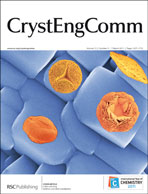Luminescence induced by strong cation–anion π–π interactions in crystals of viologen analogues†
Abstract
The crystal structures of bis[2-(1-alkyl-pyridinium-4-yl)vinyl]benzenes and their unusual structure-luminescence dependence are reported and discussed. It has been found that luminescence of viologen analogues can be activated by tuning their molecular and crystal structure (via modification of the N-alkyl substituents, exchange of anion, including or excluding the


 Please wait while we load your content...
Please wait while we load your content...